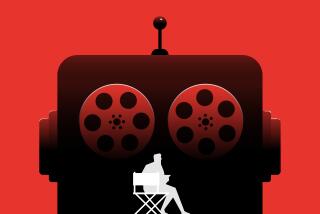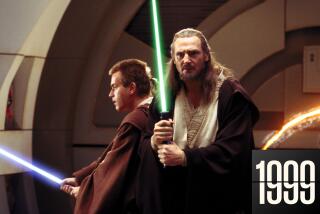Lucas Shoots for âStarsâ With Digital
LAS VEGAS â Having finished much of the shooting for âStar Wars: Episode Two,â producer-director George Lucas is done experimenting with digital video cameras.
Heâs sold.
âI think I can probably safely say that I will never, ever shoot another film on film,â Lucas told a crowd of TV professionals, news media and Sony executives at the National Assn. of Broadcasters convention Sunday. âItâs inconceivable to me to go back to that method of working.â
Lucas is the biggest of the big-budget filmmakers to embrace the new technology, which records images on computer chips instead of etching them onto film. In 1999, he announced plans to make the next $100-million âStar Warsâ movie with Sonyâs latest high-definition digital cameras, which are designed to replicate the look and feel of their film counterparts.
The results so far, he says, looked as good as anything heâs ever done. He predicted that âEpisode Two,â which is due to be released next summer, will look better than the previous âStar Warsâ installment, which used high-definition digital cameras for only a portion of its scenes.
Most Hollywood studios and filmmakers donât share Lucasâ enthusiasm for digital video. Many still insist that film yields richer, warmer images that are more appealing to viewers.
But the digital ranks are growing, particularly among independent filmmakers and TV producers. What Lucas is doing with âStar Warsâ could add to that momentum, predicted Martin Franks, executive vice president of CBS and a strong proponent of high-definition digital television.
âHeâs not exactly a slouch in the technical production department,â Franks said wryly. âIf itâs good enough for him . . . that certainly isnât hurting any.â
Lucas is best known for his association with special-effects-driven movies. In addition to generating the âStar Warsâ and âIndiana Jonesâ franchises, his Lucasfilm Ltd. also runs Industrial Light & Magic, one of the industryâs leading digital effects houses.
It was his love of fantasy, Lucas said, that made him chafe at the limitations imposed by film. âI knew that until we went digital, I wasnât going to be able to go where I wanted to go.â
His ultimate goal is to convert every step in the movie-making process to digital, including the way movies are transmitted to and displayed in theaters. Yet he insists that the issue isnât technology, itâs storytelling.
With digital cameras, he said, âthe medium is much more malleable.â The new cameras make it far easier to manipulate and rearrange shots, a process that Lucas said is integral to the way he constructs his stories. And they let a director review the shots as theyâre made, instead of having to wait for the film to be developed.
Never having to stop to load fresh film also helped speed and smooth the shooting, he said. The speedier pace probably will cut the shooting schedule by two weeks, Lucas estimated, saving him about $2 million.
That might not sound like much on a $100-million film, but as an independent filmmaker, Lucas said, even a 1% or 2% savings is significant.
There were trade-offs, such as the camerasâ sensitivity to extreme temperatures and the lack of a wide-screen viewfinder. All told, however, âthe advantages enormously outweigh the disadvantages,â he said.
And as the technology improves, the economic advantages of using digital video are becoming hard to resist. Not only does digital video save tens of thousands of dollars in film costs, it also cuts down on lighting and other production expenses.
Lucas said three or four other high-definition digital movies could reach the screen before his next âStar Warsâ film. Other directors who are using the technology include Francis Ford Coppola and Danny DeVito.
More to Read
The biggest entertainment stories
Get our big stories about Hollywood, film, television, music, arts, culture and more right in your inbox as soon as they publish.
You may occasionally receive promotional content from the Los Angeles Times.











